
Google Benefit from News Content
Economic Study
by News Media Alliance
June 2019

2
EXECUTIVE SUMMARY: The following study analyzes how Google uses and benefits from news. The
main components of the study are: a qualitative overview of Google’s usage of news content, an analysis of
news content on Google Search, and an estimate of revenue Google receives from news.
I. GOOGLE QUALITATIVE USAGE OF NEWS
▪ News consumption increasingly shifts towards digital (e.g., 93% in U.S. get some news online)
▪ Google has increasingly relied on news to drive consumer engagement with its products
▪ Some examples of Google investment to drive traffic from news include:
o Significant algorithmic updates emphasize news in Search results (e.g., 2011 “Freshness”
update emphasized more recent search results including news)
▪ Google News keeps consumers in the Google ecosystem; Google makes continual updates to
Google News including Subscribe with Google (introduced March 2018)
▪ YouTube increasingly relies on news: in 2017, YouTube added “Breaking News;” in 2018,
approximately 20% of online news consumers in the US used YouTube for news
▪ AMPs (accelerated mobile pages) keep consumers in the Google ecosystem
II. GOOGLE SEARCH QUANTITATIVE USAGE OF NEWS CONTENT
A. Key statistics:
▪ ~39% of results and ~40% of clicks on trending queries are news results
▪ ~16% of results and ~16% of clicks on the “most-searched” queries are news results
B. Approach
▪ Scraped the page one of desktop results from Google Search
o Daily scrapes from February 8, 2019 to March 4, 2019
o Geographic locations randomized within the US
o Results based on queries without user information
▪ Generated Search query terms and volumes from (i) most popular keywords identified by Ahrefs, (ii)
keyword expansion on Ahrefs, and (iii) trending queries from Google Trends
▪ Identified news domains from News Media Alliance and Google News
▪ Developed click-through rates and click curve by page location based on third-party research
▪ Tested robustness for weighting by only the search volume or only the click-through rate curves
III. GOOGLE’S HISTORIC GOOGLE NEWS VALUATION SUGGESTS THEY RECEIVE
AN ESTIMATE OF $4.7B FROM NEWS CONTENT TODAY
Google revenue from news content is estimated at $4.7 billion in 2018, based on these assumptions:
▪ Revenue estimate includes news content on Google Search and Google News
▪ Google News in 2008 generated approximately $100M for Google properties
▪ Google News contributes a constant ratio over time to revenue on Google properties
▪ Traffic from Google Search contributes to revenue on Google properties as Google News does
▪ News on Google Search is at least 6x larger than news consumption on Google News (based on a
lower bound of the ratio of referral traffic from select publishers)
This value is conservative in excluding Google advertising revenue from publisher properties and data
collected from news content. Adjusting for these can increase the estimate.

3
GOOGLE BENEFIT FROM NEWS CONTENT
IV. SUMMARY
1. Since the rise of the global Internet in the early 1990s,
1
the news industry has undergone a continuous
shift toward online news consumption. Pew Research Center found that in 1995, only 2% of the U.S. population
went online at least three days a week to get news. That number had increased to 23% by 2000.
2
In June 2018,
roughly nine-in-ten adults (93%) in the U.S. accessed at least some news online.
3
Most importantly, this shift
to online fundamentally changed how consumers access and consume news content. For example, Pew
Research Center’s study in 2016 found that more digital news consumers get their news online in the process
of accomplishing other digital tasks (55%) than specifically seek the news out.
4
Additionally, the shift to online
was followed by a further shift from desktop to mobile devices. A Pew Research Center survey found that 88%
of U.S. adults get news on a mobile device at least some of the time, up from 72% in 2016 and 54% in 2013.
5
These major shifts in the news industry have allowed for increasing engagement of emerging technology players
at the expense of news publishers who had traditionally relied on news subscriptions.
2. Google has emerged as a major gateway for consumers to access news. In 2011, Google Search
combined with Google News accounted for the majority (approximately 75%) of referral traffic to top news
sites.
6
Since January 2017, traffic from Google Search to news publisher sites has risen by more than 25% to
approximately 1.6 billion visits per week in January 2018.
7
Corresponding with consumers’ shift towards
Google for news consumption, news is becoming increasingly important to Google, as demonstrated by an
increase in Google searches about news.
8
The importance of news to Google is also reflected in its increasing
reliance on recent content to improve its search engine infrastructure and search algorithm over the years.
1
Percentage of U.S. population using the Internet grew drastically from 0.8% in 1990 to 43% in 2000;
https://data.worldbank.org/indicator/IT.NET.USER.ZS?locations=US&name_desc=false.
2
http://www.people-press.org/2004/06/08/i-where-americans-go-for-news/.
3
http://www.journalism.org/fact-sheet/digital-news/; http://www.journalism.org/2016/07/07/pathways-to-news/.
4
http://www.journalism.org/2016/07/07/digital-distinctions/.
5
http://www.pewresearch.org/fact-tank/2017/06/12/growth-in-mobile-news-use-driven-by-older-adults/;
http://www.pewresearch.org/fact-tank/2018/07/17/use-of-mobile-devices-for-news-continues-to-grow-outpacing-
desktops-and-laptops/.
6
Pew Research Center’s Project for Excellence in Journalism, Navigating News Online: Where People Go, How They
Get There and What Lures Them Away, 2011. For top news sites in this study, 60%-65% of visits were through direct
traffic, and 35%-40% were through referral sites; Google Search and Google News accounted for 30% of the traffic to
these top news sites.
7
http://blog.chartbeat.com/2018/02/15/google-is-up-what-to-do-about-it/.
8
Numbers representing search interest relative to the highest point on the chart for the given region and time. A value
of 100 is the peak popularity for the term. A value of 50 means that the term is half as popular. A score of 0 means there
was not enough data for this term. The increase in interest can be seen in searches for terms like “breaking news:”
https://trends.google.com/trends/explore?date=all&geo=US&q=breaking%20news.

4
V. GOOGLE PROVIDES A SET OF CONSUMER PRODUCTS MAKING SIGNIFICANT
USE OF NEWS CONTENT
A. Google Search incorporates news content in featured snippets such as top stories
3. Google’s aim is to “organize the world’s information and make it universally accessible and useful.”
9
As Google’s main product, Google Search indexes billions of webpages to enable users to search and discover
information through the use of search queries.
10
Google Search has become a dominant search engine tool
worldwide with a global market share of approximately 93% as of January 2019, while the second player Bing
has 3% global market share.
11
During the last quarter of 2018, Google Search accounted for 93% of overall
U.S. search engine visits and 96% of mobile visits.
12
4. Google Search relies heavily on news content to increase user engagement. It is used by consumers to
access information from news publishers and other sources.
13
Consumers can either search directly for news
online, or receive news content alongside search results. Specifically, Google Search incorporates news content
in search results, including featured snippets such as “Top Stories” carousels. In 2014, Google launched “In
the News” as a new type of search result display, with the goal to make it easier for users to get the latest news
and information.
14
In 2016, Google replaced “In the News” with “Top Stories” carousels to make the desktop
user interface match the mobile version.
15
This update was both an aesthetic change to Google Search and also
reflected Google’s efforts to visually distinguish high-quality news content from rest of the search results in
response to consumers’ need for accurate news stories.
16
9
https://about.google/.
10
https://techcrunch.com/2008/07/25/googles-misleading-blog-post-on-the-size-of-the-web/.
11
http://gs.statcounter.com/search-engine-market-share.
12
https://www.statista.com/statistics/625554/mobile-share-of-us-organic-search-engine-visits/.
13
Philipp Schindler, Google Chief Business Officer: “People come to Google looking for information they can trust,
and that information often comes from the reporting of journalists and news organizations around the world.”
https://www.blog.google/outreach-initiatives/google-news-initiative/announcing-google-news-initiative/
14
https://searchengineland.com/google-knowledge-graph-now-news-box-203073; In response to initial complaints
about “In the News” feature, Google responded that “Google Search has made an update that will make it easier for
users to get the latest news and information in real-time with fresh content coming from across the web. The goal of
Search is to get users the right answer at any one time as quickly as possible - so results may include an article from an
established publisher or from a smaller niche publisher-- or indeed it might be a press release or a relevant social post…
We believe this change is good for web publishers.” https://productforums.google.com/forum/?hl=en#!category-
topic/news/RnL_yMOyS6g.
15
https://searchengineland.com/google-replaces-news-box-top-stories-desktop-264993.
16
https://mashable.com/2016/11/21/google-replaces-in-the-news-section/#Qra2YnZm3mqW.

5
(Google Search results for “iphone”, retrieved February 12, 2019)
5. Google Search has evolved over the years to put a greater emphasis on more recent content by updating
its search engine architecture and search algorithm. Due to the fast changing nature of news content, Google
has continuously invested in improving its crawlers over time such that they could scan news sites more
frequently, adding recent content to the index within seconds of publication.
17
This reflects the increasing
importance of freshness of news content that Google displays in its “Top Stories” carousels. For example, the
Google Caffeine update in 2009 upgraded the search engine infrastructure to allow Google Search to quickly
index and present up-to-date content.
18
The completion of this new web indexing system allowed Google
Search to immediately provide 50% fresher search results than Google’s last index infrastructure.
19
The Caffeine
update has fundamentally changed how consumers access news content because it enabled Google to crawl
information from a recently published webpage and display it among search engine results pages (SERPs) nearly
instantly.
20
Building on the Caffeine update, Google announced a Freshness update in 2011 to better determine
when to deliver search results that are fresher (e.g. current events, hot topics, recurring events) in order to be
more relevant to users.
21
The updated search ranking algorithm largely affected approximately 35% of search
queries. As a result, Google Search largely prioritized the rankings of a number of news publisher sites in the
17
https://apnews.com/693f55e3781a4c53a390a1e3b917c76e.
18
https://webmasters.googleblog.com/2009/08/help-test-some-next-generation.html.
19
https://webmasters.googleblog.com/2010/06/our-new-search-index-caffeine.html.
20
https://searchengineland.com/googles-new-indexing-infrastructure-caffeine-now-live-43891.
21
https://search.googleblog.com/2011/11/giving-you-fresher-more-recent-search.html.

6
search engine result pages,
22
which suggests a greater use of news content by Google Search in order to better
engage consumers.
6. In addition, Google Search Quality Rating Guidelines indicate that Google assumes most users are
searching for the most recent information for a topic,
23
and therefore the fundamental principle of Google’s
search algorithm is to display the most recent information based on how the query meanings change over time.
The guideline says that Google “will assume users are looking for current information about a topic, the most
recent product model, the most recent occurrence of a recurring event, etc., unless otherwise specified by the
query.”
24
For example, the interpretation of the query “iPhone” has changed as new iPhone models are released.
The first iPhone was introduced in 2007. Google assumes that users searching for iPhone at that time were
looking for the new first iPhone model at the time, and that most users now are looking for the most recent or
upcoming iPhone model.
7. Google Search not only uses news content to increase its user engagement, but also changes the nature
of news consumption in response to the shift to mobile. In particular, the switch to mobile combined with the
shift to online has contributed to the decline in time spent with online news.
25
In 2015, Google introduced the
Accelerated Mobile Pages (AMP) to allow news content to load significantly faster on mobile devices compared
to the publisher’s own website.
26
Since AMP pages are hosted and controlled by Google, consumers are
essentially viewing the news content within Google’s ecosystem. In the case of Google News, Google has made
AMP the default display method for all publishers using Google News on mobile, unless a publisher actively
opts out.
27
Even though AMP was supposed to help publishers deal with slow-loading mobile pages, evidence
shows that only one-third of publishers saw traffic boost from AMP.
28
In addition, publishers can advertise on
the AMP page, but news content sometimes loads faster than the advertisements on the AMP page. This has
led publishers to earn less revenue per AMP page view compared to ad revenue earned on publishers’ own
websites.
29
22
https://techcrunch.com/2011/11/07/the-winners-losers-of-googles-freshness-update-revealed/.
23
Google Search Quality Rating Guidelines 2018.
24
Google Search Quality Rating Guidelines 2018.
25
https://www.tandfonline.com/doi/full/10.1080/1461670X.2017.1397532.
26
https://googleblog.blogspot.com/2015/10/introducing-accelerated-mobile-pages.html.
27
The Cairncross Review: A Sustainable Future for Journalism, February 12
th
, 2019;
https://support.google.com/news/producer/answer/7281462?hl=en.
28
http://blog.chartbeat.com/2018/08/23/research-study-1-3-publishers-see-clear-traffic-boost-amp/.
29
https://digiday.com/media/publishers-find-google-amp-loads-fast-ad-views/.

7
B. The Google News website combines news content from many different publishers
and displays it to users on a single platform
8. Google News was founded in 2002 and was officially released in January 2006, with the goal to
“encourage readers to get a broader perspective by reading ten articles instead of one”.
30
Google News was one
of the first products that Google launched beyond its core search engine product, implying the significance of
news to Google even in the early stage of the company. As one of the major news aggregators, Google News
collects news from various sources and provides an aggregated view of news from around the world. At its
inception, Google News was crawling information from 4,000 news sources worldwide.
31
The number had
grown significantly to 50,000 news sources by 2012.
32
9. Google News is widely used by consumers in the United States. A Reuters Institute survey (2017)
reported that approximately 13% of U.S. respondents used Google News weekly in 2017.
33
As of May 2018,
Google News had approximately 150 million unique monthly visitors in the U.S., superseding top news
publisher sites such as Huffington Post (110 million), CNN (95 million), and The New York Times (70
million).
34
Furthermore, a Pew Research Center study in 2011 showed that Google News and Google Search
combined are the biggest drivers of traffic (30%) to top news sites.
35
10. Despite significant use of news content to engage consumers, Google does not pay news publishers or
consult them on how the news content is treated or displayed within the Google News platform. Google News
does not rephrase or transform crawled information, but simply aggregates news stories from one platform and
displays the news headlines as verbatim. From its inception (2002) to June 2017, Google News had been
showing a short excerpt of each news story underneath the headline, all in verbatim. The redesign of Google
News in June 2017 removed the verbatim excerpt to introduce “a clean and uncluttered look”,
36
which implies
Google’s attempt to avoid any potential dispute that might be caused by misappropriation of news content.
Today, Google News contains two major sections that were introduced in May 2018 – “Headlines” and “For
You.”
37
The “Headlines” section provides a Full Coverage feature that applies an algorithm to aggregate several
similar articles under a given topic. For each individual news article, Google News shows the headline, the
30
http://www.niemanlab.org/2011/04/google-news-founder-krishna-bharat-for-news-consumers-the-whole-
experience-is-what-counts/; https://googleblog.blogspot.com/2006/01/and-now-news.html.
31
https://www.blog.google/products/news/building-google-news-everyone-retrospective/.
32
https://www.theatlantic.com/technology/archive/2012/09/google-news-at-10-how-the-algorithm-won-over-the-
news-industry/262641/.
33
Reuters Institute Digital News Report 2017.
34
https://www.statista.com/statistics/381569/leading-news-and-media-sites-usa-by-share-of-visits/.
35
http://www.pewresearch.org/fact-tank/2011/06/02/google-drives-news/.
36
https://www.blog.google/outreach-initiatives/google-news-initiative/redesigning-google-news-everyone/.
37
https://blog.google/products/news/new-google-news-ai-meets-human-
intelligence/?utm_source=tw&utm_medium=feed&utm_campaign=io18;
https://thenextweb.com/google/2018/05/08/google-news-aims-to-fix-journalism-by-offering-an-easy-way-to-pay-for-
it/.
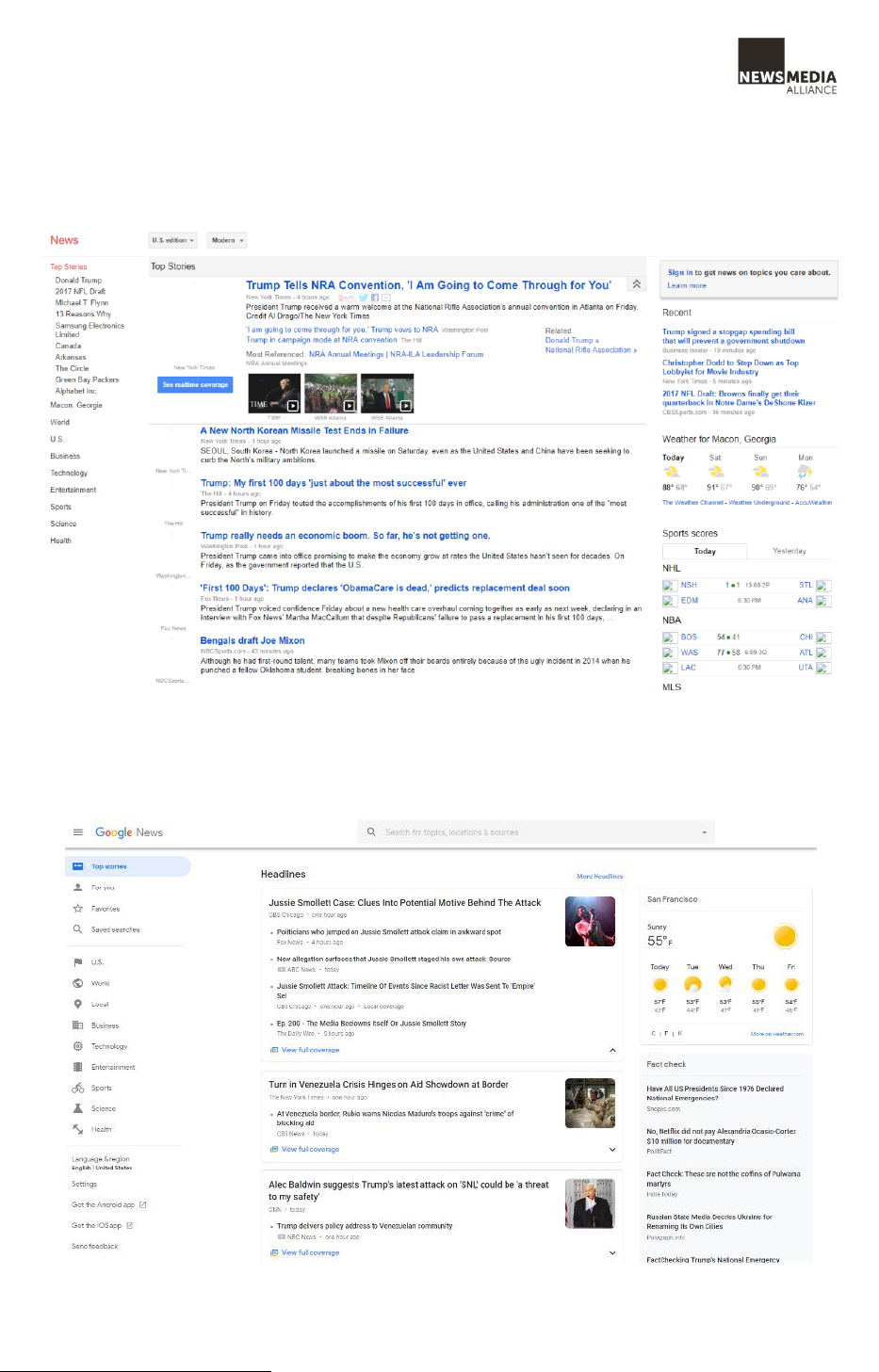
8
source, a photo or video, and a link to the original article. The “For You” section provides personalized news
recommendations based on user click behavior and browsing history.
38
(Google News site retrieved from April 29, 2017:
https://web.archive.org/web/20170429011748/https://news.google.com/)
(Google News site retrieved February 18, 2019: news.google.com)
38
Personalized news recommendation based on click behavior, 2010.
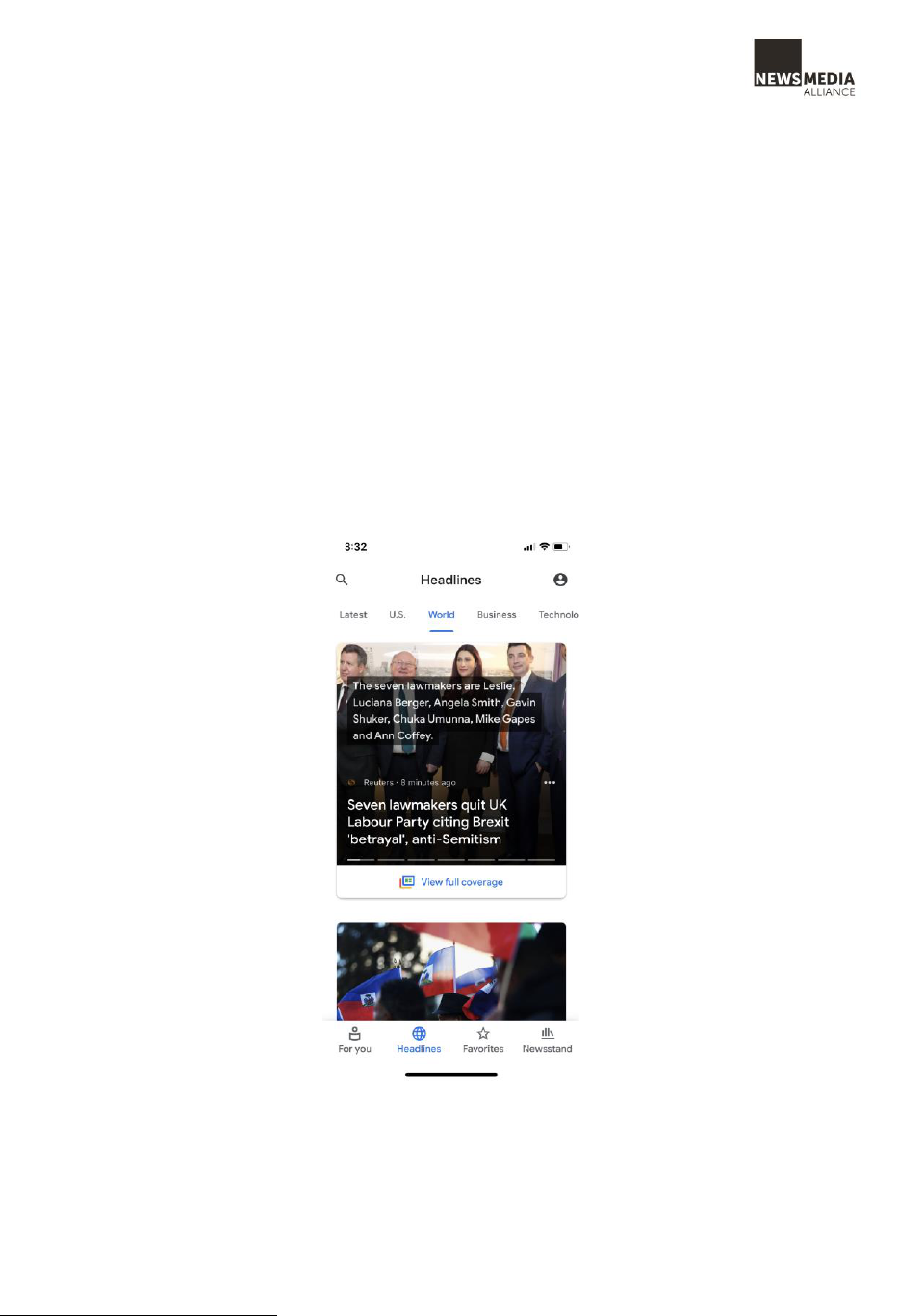
9
C. The Google News app is the mobile app version of Google News
11. The Google News app is the mobile application version of Google News. Google introduced the latest
Google News mobile app in May 2018, representing Google’s investment in streamlining the user experience
for consuming news on mobile devices. The new Google News app replaced the discontinued products Google
Play Newsstand and Google News & Weather apps on mobile.
39
Google Play Newsstand aggregated news,
magazines, blogs, and other online feeds tailored to user preferences and habits in one platform.
40
Google News
& Weather provided a comprehensive library of the latest headline stories and local news with approximately
65,000 publication sources back in 2014.
41
With the new Google News app, Google merged the core
functionalities of both Google Play Newsstand and Google News & Weather to have a single platform to better
engage consumers who consume news on mobile devices.
(The latest version of the Google News app, February 18, 2019)
12. The Google News app serves as an important channel for Google to reinforce its role in the online
news space. In March 2018, Google introduced “Subscribe with Google,” which allowed Google News
consumers to purchase subscriptions to participating news publishers directly using their Google accounts.
42
39
https://support.google.com/news/producer/answer/6016113?hl=en.
40
https://www.androidpolice.com/2013/11/20/google-play-newsstand-is-live-officially-combines-current-and-play-
magazines/.
41
https://thenextweb.com/google/2014/10/07/google-introduces-news-weather-app-ios/.
42
https://www.blog.google/outreach-initiatives/google-news-initiative/announcing-google-news-initiative/.
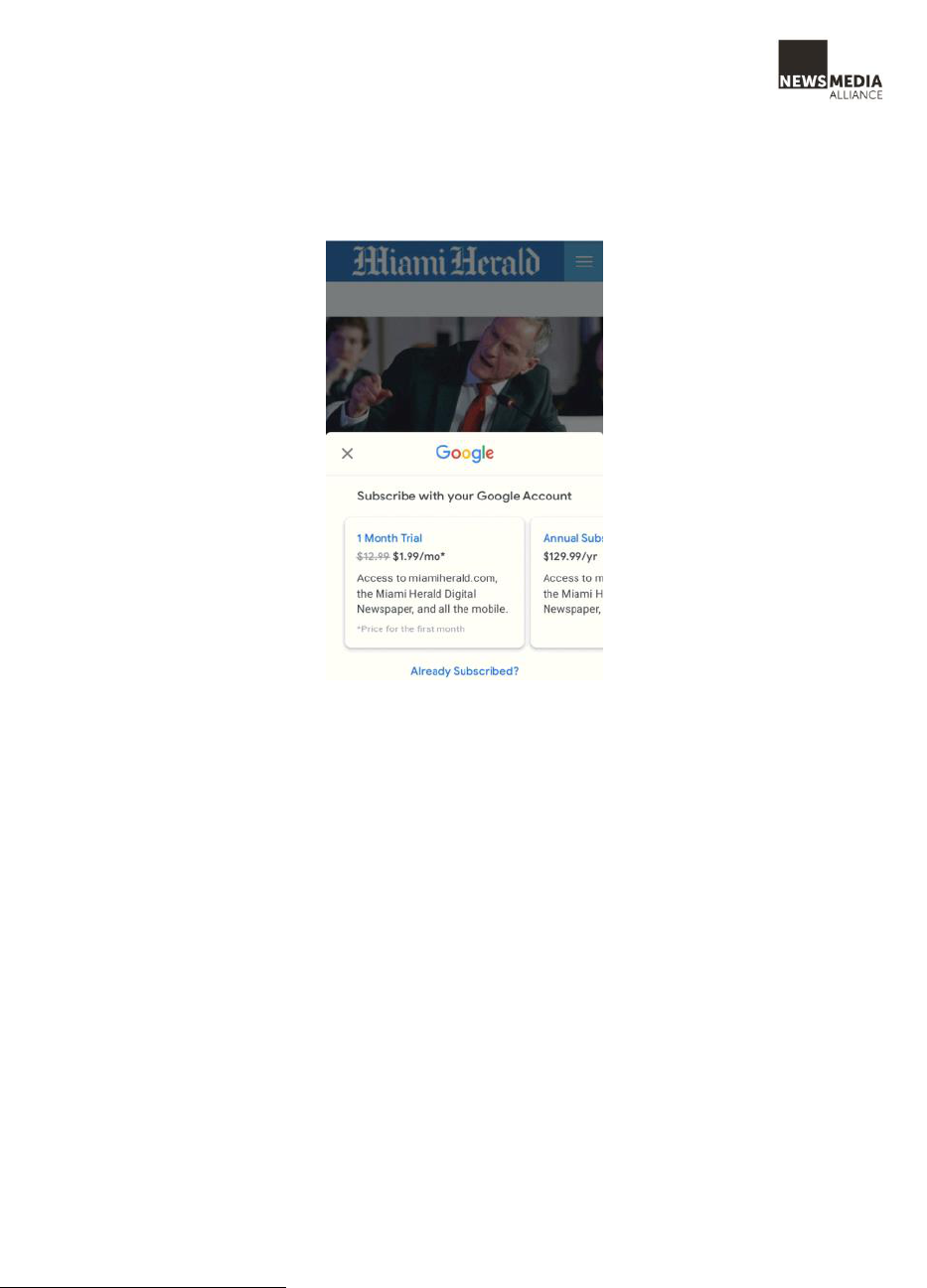
10
Google thus furthers its role as an intermediary between end consumers and news publishers, expanding its
data into all subscriptions information that an individual consumer has.
(https://www.blog.google/outreach-initiatives/google-news-initiative/announcing-google-news-initiative/)
13. As mobile applications become an increasingly popular way for users to access news,
43
the Google
News App has emerged as one of the major apps for news consumption, competing head to head against news
publisher apps and other news aggregator apps. In 2018, the Google News App ranked as the sixth most-
downloaded app in the Apple App Store and the Google Play Store combined in the U.S.
44
Additionally, the
Google News App is a particularly a strong contender when it comes to user engagement. A 2017 Reuters study
found that 13% of users used the Google News App weekly in North America, superseding other popular news
aggregator apps such as Reddit (7%), Flipboard (5%), and SmartNews (3%).
45
As of March 2019, the Google
News App had approximately 85,000 ratings in the Apple App Store with an average rating of 4.5, bypassing
major news publisher apps such as The New York Times (approx. 26,500 ratings), The Wall Street Journal
(approx.. 51,000 ratings), etc.
46
The major redesign of the Google News App in May 2018 turned it into a more
powerful tool for delivering news.
47
Due to this redesign, it is highly likely that the Google News App will be
able to gain significantly more attention at the expense of user engagement with other news aggregator apps
and news publisher apps.
43
Reuters study found that the proportion of consumers using news apps weekly increased from 18% in 2016 to 26% in
2017 in the U.S. Reuters Institute Digital News Report 2017.
44
CNN ranked as 3
rd
, Fox News ranked as 4
th
, and The New York Times ranked as 8
th
of the most downloaded news
apps in App Store and Google Play combined. https://sensortower.com/blog/top-news-apps-2018.
45
Reuters Institute Digital News Report 2017.
46
Apple App Store, March 2019.
47
https://www.businessinsider.com/google-news-vs-apple-news-2018-7#so-which-should-you-choose-9.

11
D. YouTube is a video-sharing website that includes news-related videos, along with
user generated content
14. YouTube is a video-sharing website launched in 2005,
48
offering a wide variety of videos from
corporate media and content generated by users. Users can upload, view, rate, share, and comment on videos,
and subscribe to other users and video channels on the platform. YouTube was acquired by Google in 2006
and has since been operating as one of Google’s products.
49
(YouTube homepage: https://www.youtube.com/)
15. YouTube is one of the most visited websites in the history of the Internet. Even in the early stages,
YouTube had become so successful that in 2008 it used as much online memory space as the entire Internet
used in 2000.
50
A 2018 Pew Research Center study revealed that the number of American adults using YouTube
on desktop or mobile devices had climbed to 73% — more than Facebook, which came in at 68%.
51
As of
2018, YouTube had 1.8 billion registered users who were actively watching videos on the platform.
52
More than
1 billion hours of YouTube videos are watched on a daily basis.
53
In addition, a 2017 BI Intelligence study
found that YouTube was the top digital platform for millennials with the highest average monthly time spent
48
https://www.telegraph.co.uk/news/uknews/2480280/YouTube-Overnight-success-has-sparked-a-backlash.html.
49
https://www.nytimes.com/2006/10/09/business/09cnd-deal.html.
50
https://www.telegraph.co.uk/news/uknews/2480280/YouTube-Overnight-success-has-sparked-a-backlash.html.
51
http://www.pewinternet.org/2018/03/01/social-media-use-in-2018/.
52
https://www.theverge.com/2018/5/3/17317274/youtube-1-8-billion-logged-in-monthly-users-brandcast-
2018?fbclid=IwAR040yAAkJnjSvsi8kxOZTwGpVmB6rQ9JSaV2YvO5wFhiFTow72Qu0cMDx4.
53
http://www.businessofapps.com/data/youtube-statistics/.

12
(1,163 minutes), with significant advantage over other contenders such as Facebook (744 minutes) and Netflix
(510 minutes).
54
16. YouTube has also emerged as one of the major social media platforms for consumers to access news
online. For instance, a 2018 Reuters Institute survey found that 20% of online news consumers used YouTube
as a source of news in the U.S.
55
A Pew Research Center study in 2018 found that nearly four-in-ten YouTube
users got news from the platform (38%), up from 32% in 2017 and 21% in 2016.
56
In 2016, 48% of U.S. adults
used YouTube and about one fifth of them got news from the site.
57
17. News content is also important to YouTube, which can be evidenced by significant investment Google
has made in developing the news usability on the YouTube platform. For example, YouTube launched and
expanded YouTube TV,
58
a live TV streaming service that offers content from more than 70 TV channels, with
many news networks.
59
Furthermore, in 2017, YouTube added a “Breaking News” section at the top of users’
feeds on the homepage to display authoritative news videos.
60
In 2018, YouTube invested $25 million in grants
to support online video capabilities of news organizations, and formed a working group of newsrooms
dedicated to developing new products for journalists.
61
YouTube’s chief business officer stated that “we’re
doing this because, while we see the news industry changing, the importance of news is not.”
62
54
https://www.businessinsider.com/millennials-still-watch-tv-despite-cord-cutting-increases-2017-11?r=UK&IR=T.
55
Reuters Institute: Digital News Report 2018.
56
http://www.journalism.org/2018/09/10/news-use-across-social-media-platforms-2018/.
57
http://www.journalism.org/2016/05/26/news-use-across-social-media-platforms-2016/.
58
https://techcrunch.com/2017/02/28/youtube-launches-youtube-tv-its-live-tv-streaming-service/;
https://techcrunch.com/2017/07/20/youtube-tv-triples-its-footprint-with-launches-in-10-more-u-s-markets/.
59
https://tv.youtube.com/welcome/.
60
https://techcrunch.com/2017/08/18/youtube-starts-delivering-breaking-news-on-its-homepage-across-platforms/.
61
https://www.wired.com/story/youtube-debuts-plan-to-promote-fund-authoritative-news/.
62
https://www.wired.com/story/youtube-debuts-plan-to-promote-fund-authoritative-news/.

13
(Homepage of YouTube TV retrieved March 7, 2019: https://tv.youtube.com/welcome/)
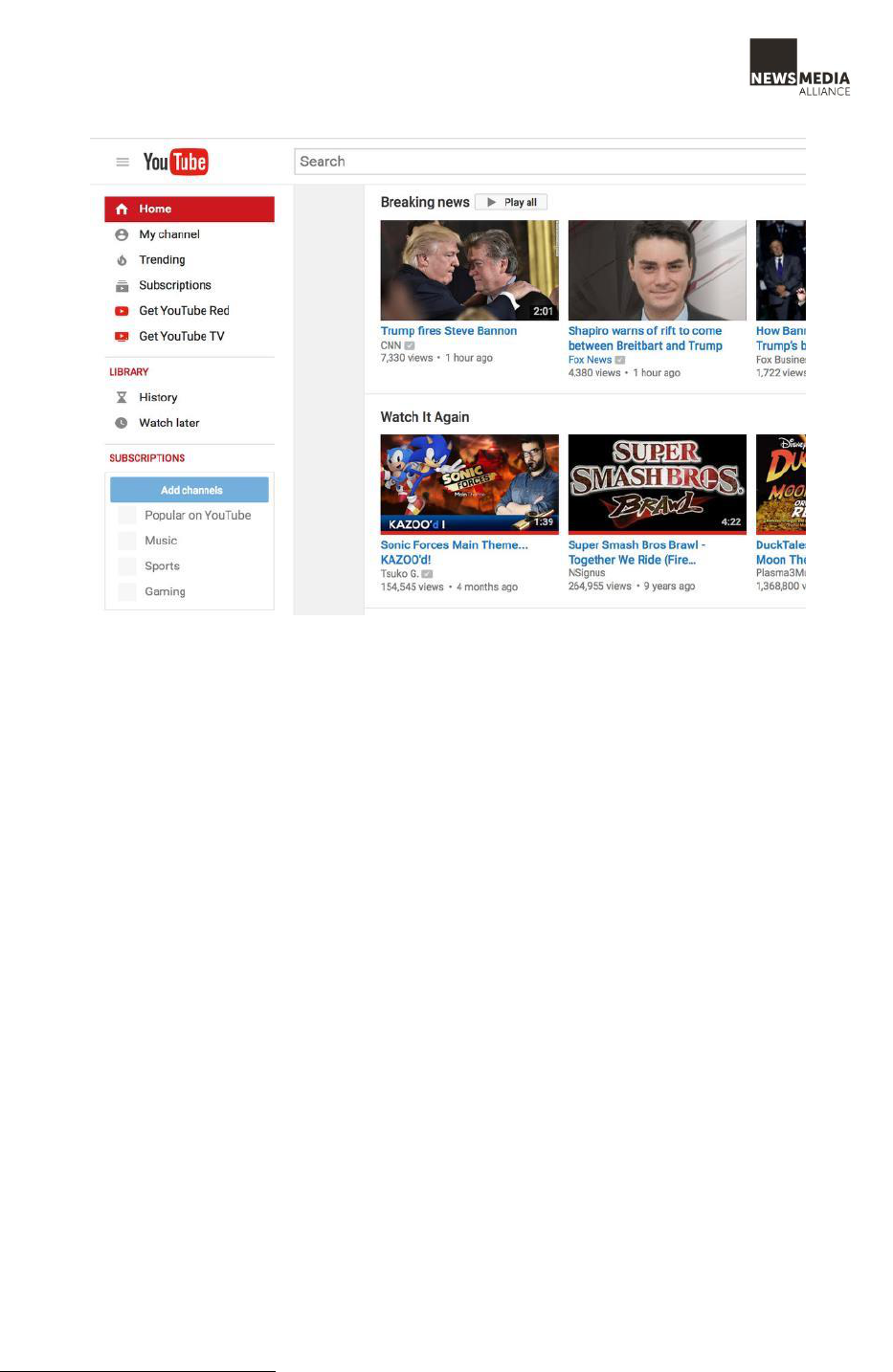
14
(“Breaking News” section on YouTube: https://www.theverge.com/2017/8/18/16171876/youtube-
breaking-news-section-homepage-mobile-apps-suggested-content)
E. Google Alerts allows users to monitor the web for interesting new content
18. Launched in 2003,
63
Google Alerts is a notification service that alerts consumers to new mentions of
subjects that matter to them. It allows users to receive emails when new results for a topic show up in Google
Search.
64
63
https://money.cnn.com/2016/04/04/smallbusiness/naga-kataru-google-alerts/.
64
https://support.google.com/websearch/answer/4815696?hl=en.
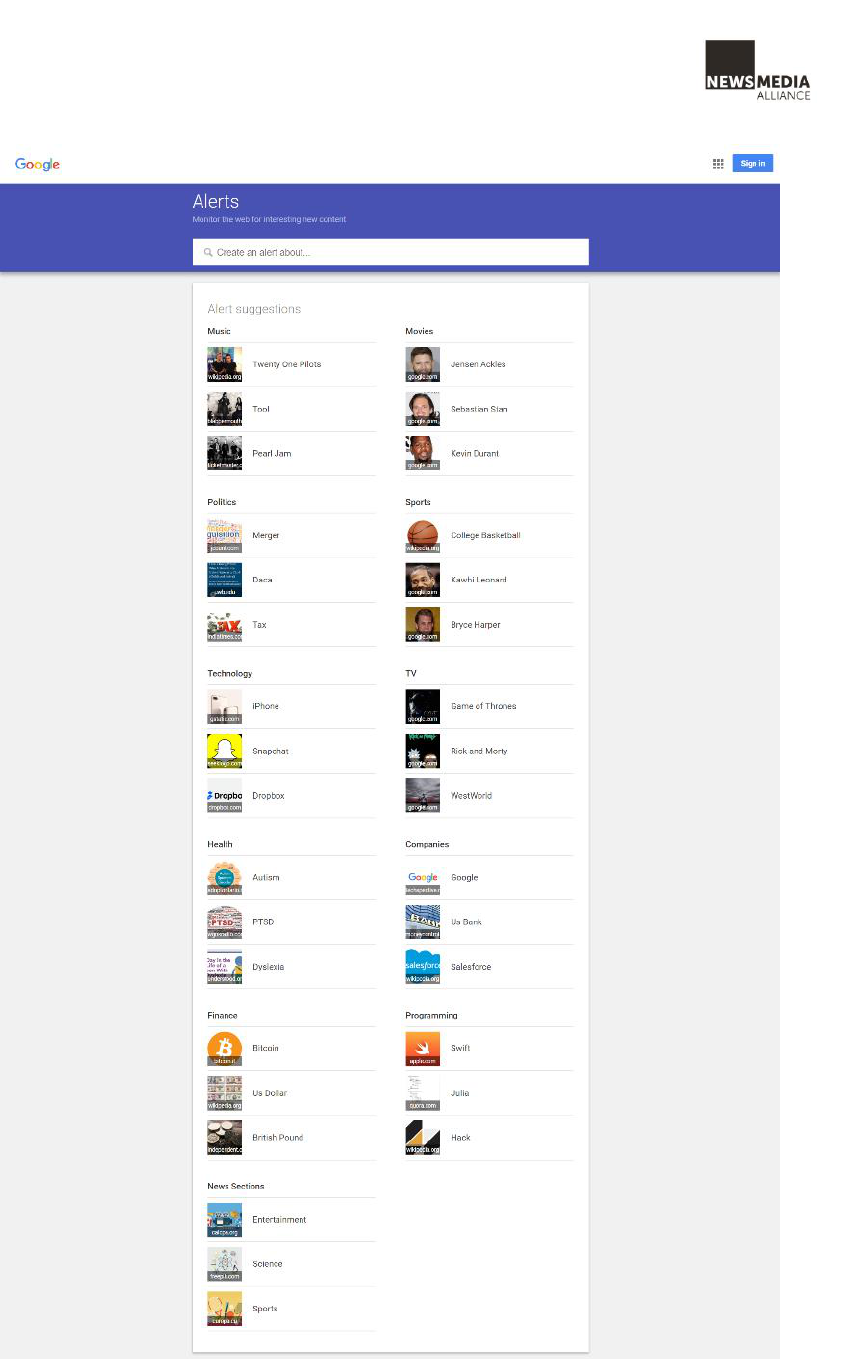
15
(Google Alerts suggestions retrieved March 7, 2019: https://www.google.com/alerts)

16
19. Google Alerts serves as an important channel to access news for users who have created or are
exploring the alerts on news updates. For instance, the default Google Alerts suggestions include a “News
Sections” that has entertainment, science, and sports as three major topic categories. Additionally, the majority
of the alerts suggestion topics for which users can get notifications on include content from news sources. For
example, when entering “iPhone” into the Google Alerts search bar, a list of preview results includes 10 news
results and five web results. This implies that, in addition to Google’s core products (Google Search, Google
News, and YouTube), Google Alerts is another Google product that heavily uses news content to engage users.
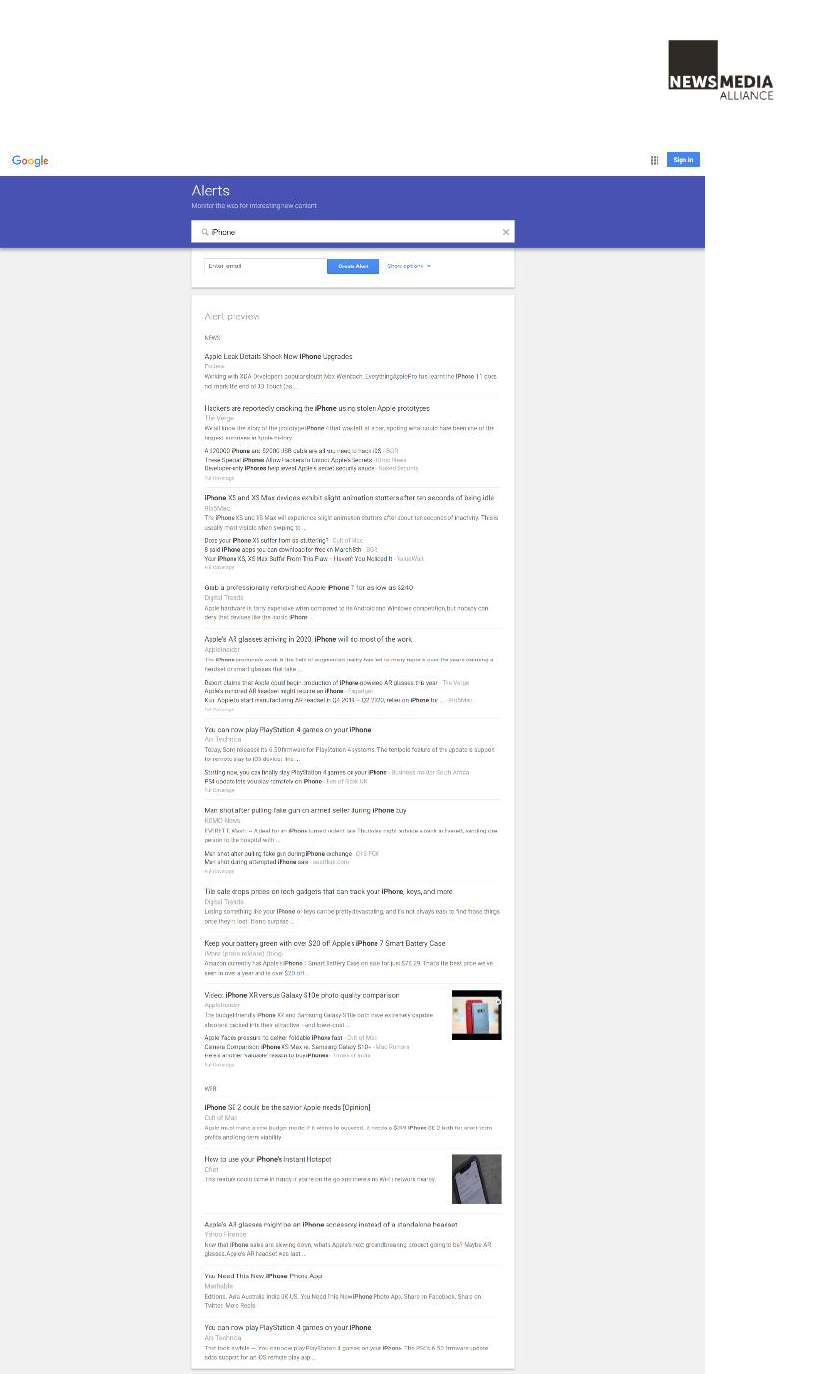
17
(When entering “iPhone” as the keyword, Google Alerts presents a preview of the alerted content; retrieved
March 8, 2019)

18
F. Gmail, Android and other services that don’t use news
20. Google also offers additional core products and services that do not heavily rely on news content,
including G Suite, Android mobile operating system, etc. G Suite is a collection of collaboration, productivity,
and storage services.
65
G Suite is mostly comprised of Gmail (a free email service), Google Doc (an online
documents service), Hangouts (a communication platform), and Calendar (a time management and schedule
calendar service) . Android is a mobile operating system developed by Google in 2008.
66
These additional
Google services currently do not heavily leverage news content.
VI. GOOGLE USES NEWS CONTENT TO DRIVE TRAFFIC AND REVENUE
A. Google uses a significant volume of news content to keep users within its ecosystem,
also allowing Google to capture user data and thus improve its core services
21. Google provides consumers news content through its search results; the volume of news content that
consumers encounter depends on a number of factors, including:
a. The set of queries consumers run, estimated based on representative queries,
b. the results of those queries, found from running those queries and tracking the results,
c. and the click patterns of consumers on those queries, estimated based on SERP click patterns.
22. Estimation of Google Search’s usage of news is based on scraping representative sets of queries and
analyzing the volume of news content in those.
67
1) Three datasets provide samples to measure news content
23. To estimate the amount of news on Google Search, data was scraped from Google Search daily
between February 8 and March 4, 2019. Three search query datasets were constructed for the empirical analysis.
These datasets consisted of search result listings for trending queries growing in popularity, listings for 200
most searched queries, and listings for a much larger (11,839) set of high-volume queries. All three search query
datasets include the search keyword and a measure of search volume or query frequency for each search query.
65
https://gsuite.google.com/.
66
https://android-developers.googleblog.com/2008/09/announcing-android-10-sdk-release-1.html.
67
Analysis of usage performed by Keystone Strategy. Keystone is an innovative economics and strategy consulting firm
delivering transformative ideas on leading-edge challenges in technology, business, and science. With offices in New
York, Boston, San Francisco, and Seattle, Keystone works with a broad range of clients including technology companies
and government organizations. For more details, visit .

19
24. The first search query dataset, “Trending queries,” consists of trending queries from the Google
Trends site. On a given day, Google Trends publishes up to 20 trending queries ranked by daily search volume.
68
Google dynamically updates the daily search volume for all search queries entered into Google Search on a
given day, and thus the top 20 trending queries may change throughout the day depending on the latest daily
search volume. The trending queries and their final daily search volume were recorded daily from Google
Trends site from February 8, 2019 – March 4, 2019.
69
25. The second search query dataset, “Top 200,” consists of 200 most searched queries with the highest
monthly average search volume in the U.S. as of December 2018.
70
For example, the most searched query in
this dataset is “facebook,” with an average monthly search volume of 236,700,000. The search volume shows
that the search query “Facebook” is being entered into Google Search 236,700,000 times per month on average.
26. The third search query dataset, “Most searched – expanded,” is constructed by applying keyword
expansion methodology to the second dataset of 200 most searched queries. The top 200 search queries were
used as a basis to generate a list of additional 11,639 keywords with high relevancy and high search volume.
71
The relevant keywords were generated based on four major types of relevancy: 1) phrase match (any keyword
phrases that contain the exact same seed phrase in them); 2) having same terms (any keyword phrases that
contain any terms of the seed phrase); 3) also rank for (keyword phrases ranked by the top 10 ranking pages
for the seed phrase); 4) search suggestions (keyword phrases that Google Search suggests via its “autosuggest”
feature). For example, one of the most searched queries “youtube” has approximately 195 million monthly
searches. The keyword expansion methodology enables the discovery of search queries that are highly relevant
to “youtube” and have high search volume, such as “you tube” (14 million monthly search volume),
“youtube.com” (2.9 million monthly search volume), and “youtube music” (1.9 million monthly search
volume). This approach resulted in a total of 11,839 unique search queries with high monthly search volume in
the third search query dataset.
27. For each query identified in the three search query datasets, a scraper pulled all results on the search
engine result page (SERP) generated for each search query. Queries were pulled for multiple days and from
multiple geographic locations. For example, the query for “youtube” may yield 11 search result listings on the
first search engine result page (as exemplified in the screenshot below). There are seven organic listings, three
68
For a few days, Google Trends publishes 18 trending queries per day.
https://trends.google.com/trends/trendingsearches/daily?geo=US.
69
In order to get the final daily search volume, the top 20 trending queries from the day before were scraped on any
given day between February 7, 2019 and March 3, 2019.
70
https://ahrefs.com/blog/top-google-searches/.
71
https://ahrefs.com/keywords-explorer. Keywords from the Top 200 list were entered into Ahrefs database each time
to generate approximately 100 relevant keywords with high search volume, which was repeated. 20,000 relevant
keywords were then compiled, removing duplicates to find a total of 11,639 unique keywords.
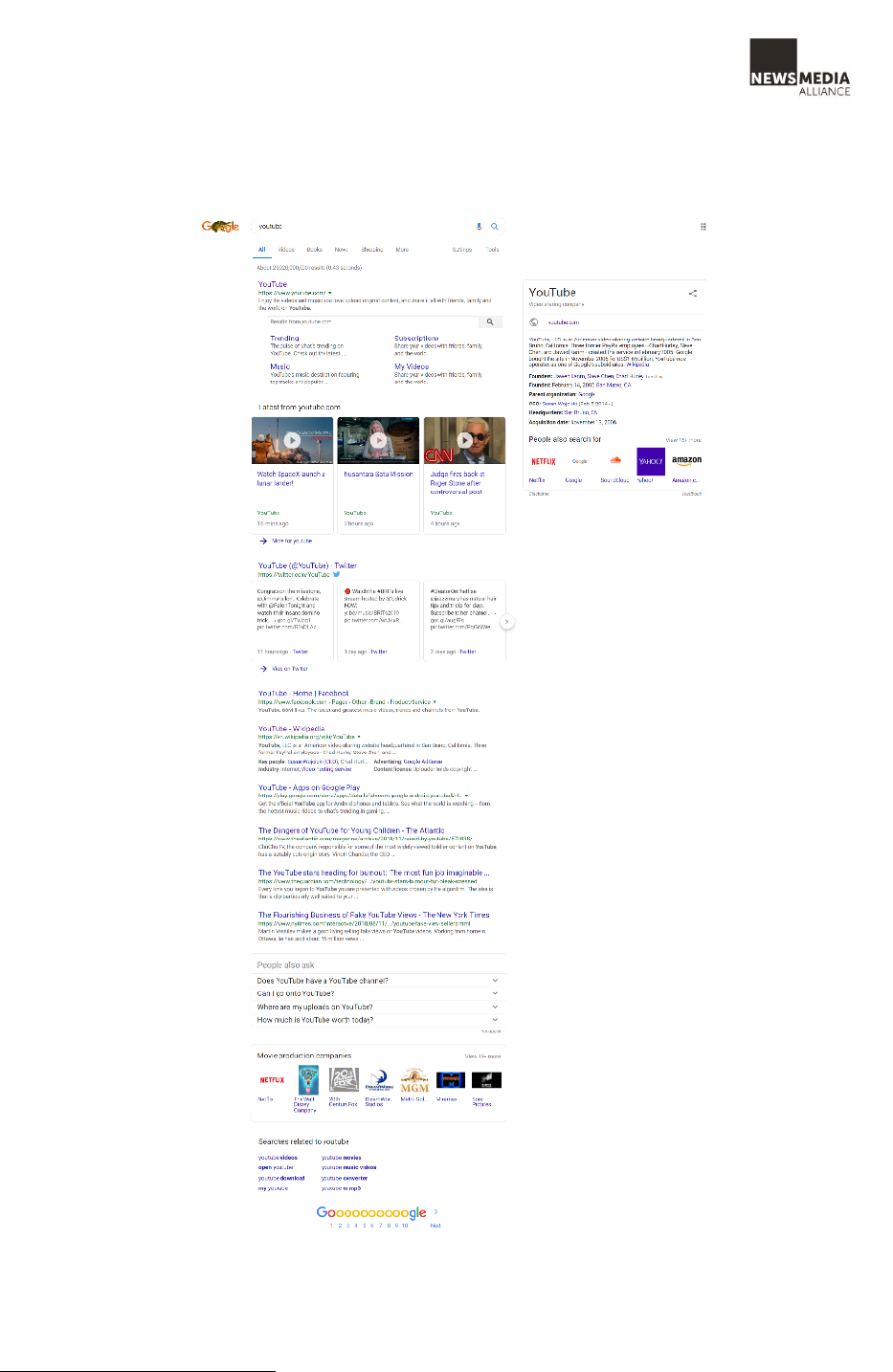
20
video listings from YouTube.com, and quote listings from Twitter.
72
No paid advertisement listing is yielded in
this example.
(Google Search results for “youtube” retrieved February 21, 2019)
72
The three Twitter search result listings were scraped as one search result because all three listings are linked to Twitter
URLs.

21
28. For each search query, the scraped results include which U.S. city (i.e. “location”) and when (i.e. “date
time”) the first SERP for the query is scraped. There are approximately 10 to 20 search result listings on the
first SERP for any given query. For each search result listing on the first SERP, key characteristics about the
listing include whether the listing is an organic or paid result, rank position, rank position within a carousel
listing, title of the listing, URL, how the listing is displayed (e.g. Top Stories carousel), etc. A full list of scraped
data points can be found in VIII. Appendix.
29. A search result listing is identified as news content based on the result’s domain and a list of news
publisher domains. Examples of news domains include major news sites (such as foxnews.com, nytimes.com,
usatoday.com, etc.) and smaller local news sites. The set of domains is constructed using news sources from
two sources. The first is a list of URLs of News Media Alliance members. The second comes from a dataset of
422,937 news webpage URLs.
73
Domains that are not primarily news but appeared in the list were then
removed.
74
This constructed news URL list contains 11,258 domains but does not include all news sites in the
world, and so the estimates of news content serve as a lower bound.
30. To illustrate the application, when the query “iPhone” returns a search result listing that is a news story
about iPhone from Forbes (forbes.com), this listing will be labeled news because forbes.com has been identified
as news content in the constructed news URL list. When the query “iPhone” returns a search result listing of
Apple’s website (apple.com), this listing will not be labeled as news because apple.com is not a news URL based
on the constructed URL list. This cross-reference analysis is applied to all search result listings in the final
scraped dataset.
2) Approximately 39% of content on Trending Queries and 16% on high-volume
queries in Google Search is news content
31. Table 1 below shows a summary of the fraction of results from each sample that are news results.
Table 1: Percentage of Google Search results linking to news domains on query samples
Percentage of Google Search results
linking to news domains
Trending queries
38.7%
Top 200 queries
20.6%
High volume search queries
16.4%
73
UCI Machine Learning Repository https://archive.ics.uci.edu/ml/datasets/News+Aggregator; Gasparetti, F. (2017).
Modeling user interests from web browsing activities. Data mining and knowledge discovery, 31(2), 502-547.
74
E.g., youtube.com and linkedin.com, which occasionally house news content linked to by Google News.

22
32. These results describe the volume of news content in search engine results on Google. While the
Trending queries statistic of 38.7% indicates the significance of news content to consumers searching for the
latest information, the 16.4% represents the significance of news content in the most common queries
consumers submit.
3) Approximately 40% of clicks on Trending Queries and 16% on high-volume queries
in Google Search are news content
33. Another estimate of Google’s reliance on news clicks for Google Search comes from weighting search
results by query volume and location on the search engine results page. For example the query “facebook” has
an estimated monthly volume of 236,100,000, relative to the query “khan academy,” which has an estimated
monthly volume of 3,360,000.
75
And while the top listing on the search engine results page for the query for
“facebook” is a set of links to facebook.com, below that are the top news stories for facebook.
76
34. The other adjustment depends on the position of certain results on the page, for example the top result
on a SERP is estimated to get between two and four-times as many clicks as the next highest result, and results
on the bottom of a page receive almost no clicks.
77
35. Table 2 summarizes the percentage of news clicks from the samples, after adjusting for these two
factors:
78
Table 2: Percentage of news clicks from Google Searches for query samples, weighted for click-
through rate and query volume
Percentages of news clicks
Trending queries
40.1%
Top 200 queries
16.1%
High volume search queries
15.7%
75
Estimated by Ahrefs for October 2018.
76
As of April 2019.
77
On desktop, see https://www.advancedwebranking.com/ctrstudy/ or https://seo-hacker.com/lesson-28-important-
page-serps/. Adjustment performed based on https://www.advancedwebranking.com/ctrstudy/.
78
Queries are weighted by volume based on the lower bound of volume estimates from Google Trends, and based on
the volume of searches calculated in Ahrefs. The click curve from https://www.advancedwebranking.com/ctrstudy/ is
applied to queries to adjust for different click-through rates.

23
B. Google extracts significant value from news content
36. Google makes most of its revenue from its own properties; in 2018, they brought in $96.3 billion of
Google’s $136.8 billion total annual revenue (70%).
79
While a large component of this is Google Search, most
content served on Google Search does not generate ads. According to one study, approximately 3.4% of distinct
Google search queries (2.6% of all Google search queries) resulted in a click on a paid result.
80
Yet the content
not generating ads still contributes towards Google’s “mission to organize the world’s information and make it
universally accessible and useful.”
81
1) Google News drives significant revenue for Google, even without ads
37. Content on Google Search that does not directly result in revenue still provides Google significant
benefit, as users who come to Google for free content are the same users clicking on ads. While it is difficult
to measure the monetary value of this content, Google has provided a benchmark. Specifically, Google
estimated that Google News, a product without ads, brought in an estimated $100 million in yearly revenue in
2008.
82
Although Google has provided no more recent estimates of the value of news content, the $100 million
quoted by Google for Google News (which has no ads) can be extrapolated in a straightforward way to suggest
an estimated $4.7 billion of revenue in 2018 to Google from news content on Google Search and Google
News.
83
38. The $100M in 2008 is 0.7% of Google’s 2008 revenue of $14 billion from Google websites.
84
From
2008 to 2018, revenue generated on Google websites has grown from $14 billion to $96 billion.
85
This growth
in revenue was driven by several factors including an increase in online behavior in emerging markets.
86
39. Another driver of the increase in revenue over the past few years came from improved monetization
of the ad space. Google has adjusted their product over the years, affecting how consumers interact with ads,
79
Alphabet 2018 Form 10-K.
80
https://moz.com/blog/state-of-searcher-behavior-revealed.
81
https://www.google.com/search/howsearchworks/mission/
82
Former Google VP Search Products & User Experience Marissa Mayer reported that Google News was worth
approximately $100 million during a lunch session at Fortune’s Brainstorm Tech conference in California in 2008 from
http://fortune.com/2008/07/22/whats-google-news-worth-100-million/, and “Ad-free Google News generates $100
million per year?” from https://thenextweb.com/2008/07/24/ad-free-google-news-generates-100-million-per-year/
83
Analysis by Keystone Strategy based on a Google estimate, public financials, and News Media Alliance member data.
84
Google 2008 Form 10-K page 42.
https://www.sec.gov/Archives/edgar/data/1288776/000119312509029448/d10k.htm
85
Google 2008 Form 10-K page 42.
https://www.sec.gov/Archives/edgar/data/1288776/000119312509029448/d10k.htm and Alphabet 2018 Form 10-K,
page 27 https://www.sec.gov/Archives/edgar/data/1652044/000165204419000004/goog10-kq42018.htm.
86
See, e.g., Alphabet 2018 Form 10-K, page 26.

24
growing the space devoted to advertising from 2010 to 2014, according to two studies.
87
This is depicted in the
following image:
88
40. Google has continued to adjust the ads to make them more visually appealing than organic results over
the years. For instance, Google’s Expanded Test Ads
89
in 2016 expanded the ad size to be 50% bigger with
higher click-through rates.
90
In January 2019, Google added an extra headline and description to all expanded
text ads.
91
41. Along with increased engagement on Google Search and improved monetization from queries, Google
News has also grown significantly. In 2009, Google News had approximately 24 million monthly unique visitors
in the U.S. compared to 50 million for both CNN and the New York Times.
92
In the same year, Google News
attracted 100 million unique visitors on a global scale, making it a larger news site than CNN (66 million) or
the combined properties of the New York Times (92 million).
93
In 2010, Google News ranked ninth on the list
of most popular news websites as measured by average monthly unique visitors by Nielsen, with CNN being
third and The New York Times being fifth.
94
In 2012, Google News had 65 million unique monthly visitors in
the U.S. (Yahoo! News had 110 million, CNN had 74 million, MSNBC had 73 million, The New York Times
had 59.5 million, and Huffington Post had 54 million).
95
A Reuters Institute survey (2017) reported that
approximately 13% of U.S. respondents used Google News weekly in 2017.
96
As of May 2018, Google News
87
https://moz.com/blog/google-organic-clicks-shifting-to-paid, and https://www.edwords.nl/2014/04/27/steeds-
meer-ruimte-adwords-ten-koste-van-seo/
88
https://www.edwords.nl/2014/04/27/steeds-meer-ruimte-adwords-ten-koste-van-seo/
89
https://www.blog.google/products/ads/ads-and-analytics-innovations-for-a-mobile-first-world/.
90
https://www.wordstream.com/blog/ws/2018/08/22/new-expanded-text-ads.
91
https://www.wordstream.com/blog/ws/2018/08/22/new-expanded-text-ads.
92
https://techcrunch.com/2009/12/23/google-news-cnn/.
93
https://techcrunch.com/2009/12/23/google-news-cnn/.
94
https://www.journalism.org/2011/05/09/top-25/.
95
https://www.gsb.stanford.edu/sites/gsb/files/rp3353.pdf.
96
Reuters Institute Digital News Report 2017.

25
had approximately 150 million unique monthly visitors in the U.S., superseding top news publisher sites such
as Huffington Post (110 million), CNN (95 million), and The New York Times (70 million).
97
2) News content on Google Search yields significant revenue for Google
42. While the number of unique visitors to Google News grew at an average rate of 23% per year between
2009 and 2018, over that same time period Google revenue from Google properties has grown on average 22%
per year.
98
43. This similar growth in Google News and Google properties suggests that the 2008 estimate of the
value of Google News relative to Google properties can be applied to recent years. To apply the 0.7% factor
from the value of Google News to the value of Google Search requires adjustment for the difference in scale
between Google News and Google Search. This is calculated based on the referral traffic to publisher websites.
44. Combining these factors results in a suggested estimate of Google’s benefit from news content at $4.7
billion of revenue in 2018. The calculation steps are found in Appendix B.
VII. CONCLUSION
45. News content provides significant value to Google by enabling Google Search to drive greater user
engagement. News content from news publishers not only contributes to Google Search’s freshness and quality
of the search results, but also helps inform the emerging keywords that were not previously searched on Google.
As new search queries continue to emerge,
99
Google continuously improves its Search to return fresher and
more relevant search results in response to the trending queries. News content plays an irreplaceable role in
informing improvement areas for Google Search, which ultimately helps Google build trust in its products
from users and thus keep users within Google’s ecosystem of products.
VIII. APPENDIX
A. Construction of the Google SERPs dataset
46. Search results on the first page of SERPs were scraped because they receive the most traffic. Research
shows that search results on the first search engine results page receive almost 95% of web traffic, leaving only
97
https://www.statista.com/statistics/381569/leading-news-and-media-sites-usa-by-share-of-visits/;
http://www.ebizmba.com/articles/news-websites.
98
Google properties revenue was $15.7 billion in 2009 and $96.3 billion in 2018 from Google 2009 Form 10-K and
Alphabet 2018 Form 10-K. Google News growth based on estimates of unique monthly visits.
https://techcrunch.com/2009/12/23/google-news-cnn/; https://www.statista.com/statistics/381569/leading-news-
and-media-sites-usa-by-share-of-visits/
99
In 2013, Google stated that 15% of search queries entered into Google Search had never been seen before on a daily
basis since the company’s existence. In 2017, Google reaffirmed that 15% of queries were brand new among trillions of
searches on Google every year. https://www.cnet.com/news/google-search-scratches-its-brain-500-million-times-a-
day/; https://blog.google/products/search/our-latest-quality-improvements-search/.
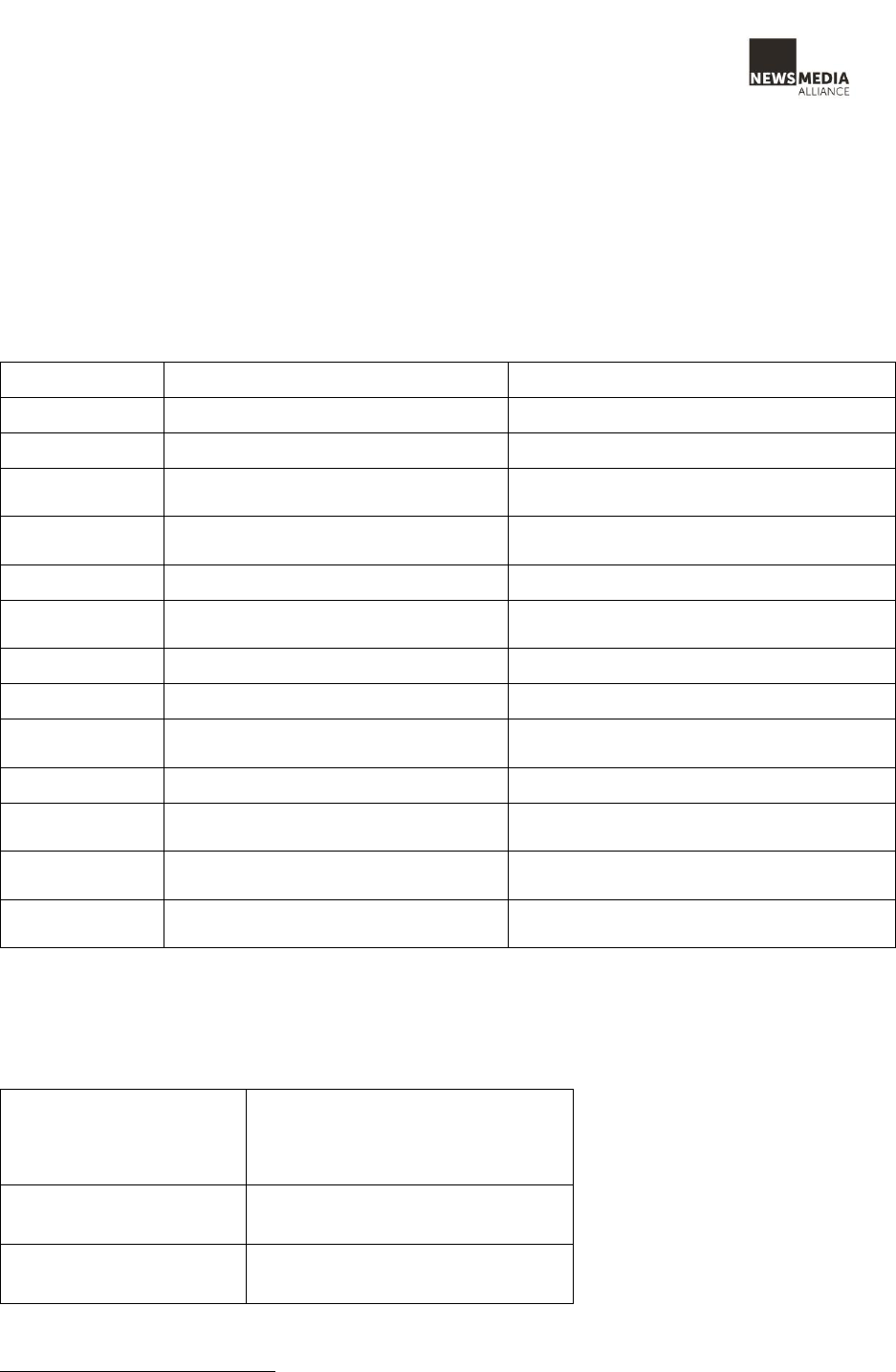
26
5% for remaining search results pages.
100
Additionally, about 65% of all clicks on SERPs go to the top five
listings.
101
Two scraping jobs were scheduled for a given day. The first job was scheduled to run at 1AM PT, and the
second job was scheduled to run at 12PM PT.
Data captured
Definition
Example
Location
U.S. city
“Fremont, CA”
Query
Search query
“facebook”
Organic or paid
Whether the search listing is organic or
paid result
“paid”
Date time
Timestamp for when the data is
scraped
“2019:02:06:18:07:57”
Listing rank
Rank position of the listing
“1”
Carousel count
For each carousel with 3 sub-results,
position of each sub-result
“2”
Title
Title of the search result
“Facebook - Log In or Sign Up”
URL
Site URL displayed under the “title”
“https://www.facebook.com/”
Snippet
A short description or intro of the
search result under the “URL”
“Create an account or log into Facebook. Connect
with friends, family and other people you know…”
Result type
How the search result is displayed
“Top Stories carousel”
Multimedia
Whether the search result includes
image or video
“Image”
Has pricing
Whether the search result includes
pricing information
“1” (i.e. the result contains pricing info)
Has rating
Whether the search result includes
review rating information
“0” (i.e. the result doesn’t contain review rating info)
B. Alternate weighting of news content in Google Search
47. The following table presents an estimate of the percentage of news listings on Google search engine
results pages, based on weighting by volume.
Volume weighted percentage of news
listings
Trending queries
41.1%
Top 200 queries
27.0%
100
https://www.brafton.com/news/95-percent-of-web-traffic-goes-to-sites-on-page-1-of-google-serps-study/.
101
https://www.advancedwebranking.com/ctrstudy/.
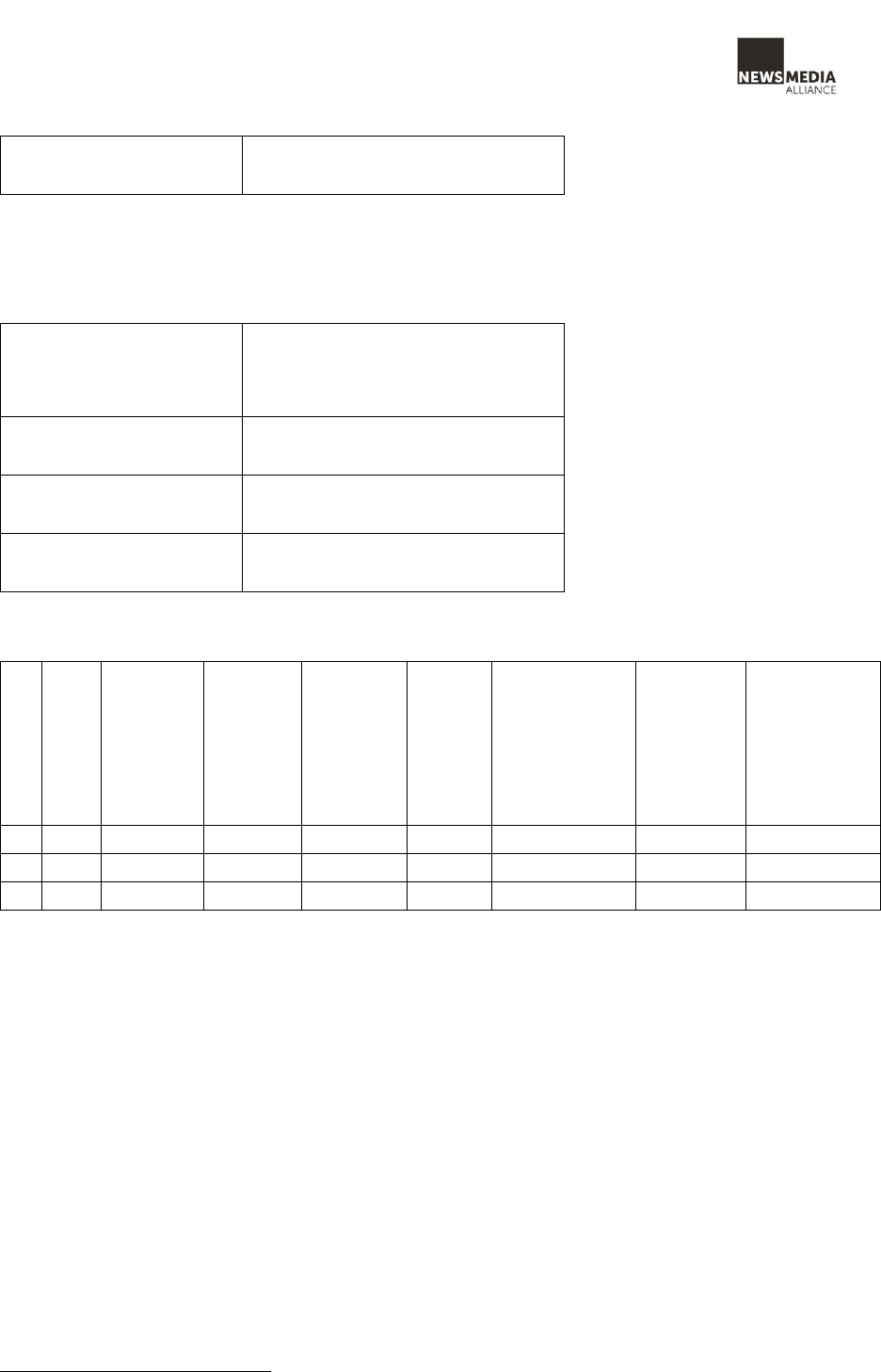
27
High volume search queries
23.8%
48. The following table presents an estimate of the percentage of news clicks on Google search engine
results pages, adjusted for the click-through rate differences of different listings on the page, but not adjusted
for different volumes of queries.
Click-through rate weighted news
clicks
Trending queries
39.5%
Top 200 queries
13.8%
High volume search queries
12.9%
C. Estimation of Google Revenue from News Content
Year
Revenue
from
Google
Properties
($billion)
Google
Stated
Value of
Google
News
($million)
Google
News
Fraction
of
Properties
Revenue
Google
News
to
Google
Search
Scaling
Factor
Fraction of
Google
Property
Revenue
attributable to
news on
Google Search
Estimated
value of
news on
Google
Search
($billion)
Estimated
value of news
on Google
Search and
Google News
($billion)
[A]
[B]
[C]
[D]
[E]
[F]
[G]
[H]
[1]
2008
14
100
0.7%
6
4.2%
[2]
2018
96
0.7%
6
4.2%
4.0
4.7
49. The “Google News to Google Search Scaling Factor” in column [E] is estimated based on referral
traffic from internal referral data from major publishers; based on comparing six full calendar years of traffic
from two publishers, the median factor differential between referrals from Google News and Google Search is
8.2 and the minimum is 6.2.
102
From these, 6.0 is selected as a conservative estimate in the difference in traffic.
50. The above table generates an estimate of Google’s annual benefit from news on Google News and
Google Search contributing approximately 4.9% to revenue generated by Google’s Properties, for a suggested
estimate of $4.7 billion in 2018.
102
Based on News Media Alliance member data.
